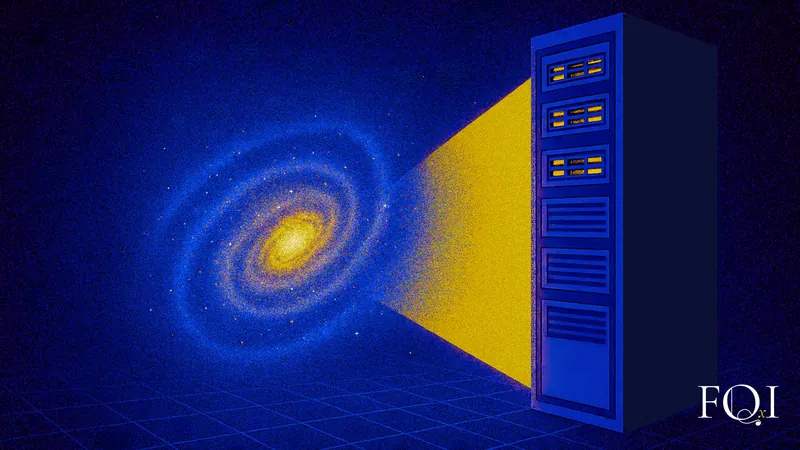
Unlocking the Secrets Before the Big Bang: A New Computational Breakthrough
2025-08-21
Author: Arjun
Is There Life Before the Big Bang?
It’s often deemed "unscientific" to ponder the events prior to the Big Bang. Yet, a groundbreaking study by FQxI cosmologist Eugene Lim from King's College London, along with researchers Katy Clough from Queen Mary University and Josu Aurrekoetxea from Oxford University, is throwing open the door to possibilities using advanced computer simulations.
Published in Living Reviews in Relativity, this innovative approach focuses on utilizing complex numerical methods to analyze Einstein's equations in extreme scenarios, aiming to decipher some of the cosmos’ most enigmatic questions.
Beyond the Limits of Gravity
Einstein’s equations of general relativity govern gravity and cosmic movement. However, as one explores the universe's beginnings, these equations spiral towards a singularity—an area of infinite density where conventional physics falls apart.
Cosmologists often simplify the universe to be isotropic and homogeneous, treating it as uniform no matter the direction you look. This assumption works well for our present universe, but it raises crucial questions about its applicability during the chaotic moments of the Big Bang.
Lim succinctly illustrates the challenge: "You can search around the lamppost, but you can't go far beyond the lamppost where it’s dark—you just can’t solve those equations,” he explains. "Numerical relativity allows you to explore regions away from the lamppost,” adding a new dimension to our quest for understanding.
The Advent of Numerical Relativity
Originally suggested in the 1960s, numerical relativity sought to explore gravitational waves generated by black hole mergers. Its significance surged with the development of the LIGO experiment in the 1980s, culminating in a successful application of the method in 2005.
Now, researchers are excited about applying these techniques to explore cosmic inflation—an explosive growth phase believed to shape our universe's current form. "If you don't have inflation, a lot of things start to unravel," Lim points out. Yet, explaining the mechanics behind this rapid expansion without assuming homogeneity has stumped scientists for decades.
Exploring Cosmic Myths and Realities
But the possibilities don't end there. Lim envisions using numerical relativity to probe hypothetical cosmic strings—distinctive 'scars' in spacetime that could lead to groundbreaking discoveries about the nature of gravity.
Moreover, researchers are keen to explore whether our universe has collided with others, leaving behind telltale signatures in the sky. Could we be on the brink of confirming multiverse theories?
There’s also the captivating concept of cyclic universes—ones that go through a series of 'bounces' between expansive and collapsed states, potentially making them eternal. "Bouncing universes are particularly intriguing," says Lim, as they require grappling with gravity at its strongest.
The Future of Cosmological Simulations
The complexity of numerical relativity necessitates the use of supercomputers, and as technology advances, our grasp of cosmic mysteries may deepen significantly. The hope is that Lim's paper will bridge the disciplines of cosmology and numerical relativity, empowering researchers to tackle questions once deemed insurmountable.
"We aim to integrate cosmologists and numerical relativists, allowing them to collaborate effectively and explore these unfathomable domains together," Lim concludes. The quest to unveil the universe's secrets, including what lay before the Big Bang, is entering an exciting new chapter.



 Brasil (PT)
Brasil (PT)
 Canada (EN)
Canada (EN)
 Chile (ES)
Chile (ES)
 Česko (CS)
Česko (CS)
 대한민국 (KO)
대한민국 (KO)
 España (ES)
España (ES)
 France (FR)
France (FR)
 Hong Kong (EN)
Hong Kong (EN)
 Italia (IT)
Italia (IT)
 日本 (JA)
日本 (JA)
 Magyarország (HU)
Magyarország (HU)
 Norge (NO)
Norge (NO)
 Polska (PL)
Polska (PL)
 Schweiz (DE)
Schweiz (DE)
 Singapore (EN)
Singapore (EN)
 Sverige (SV)
Sverige (SV)
 Suomi (FI)
Suomi (FI)
 Türkiye (TR)
Türkiye (TR)
 الإمارات العربية المتحدة (AR)
الإمارات العربية المتحدة (AR)